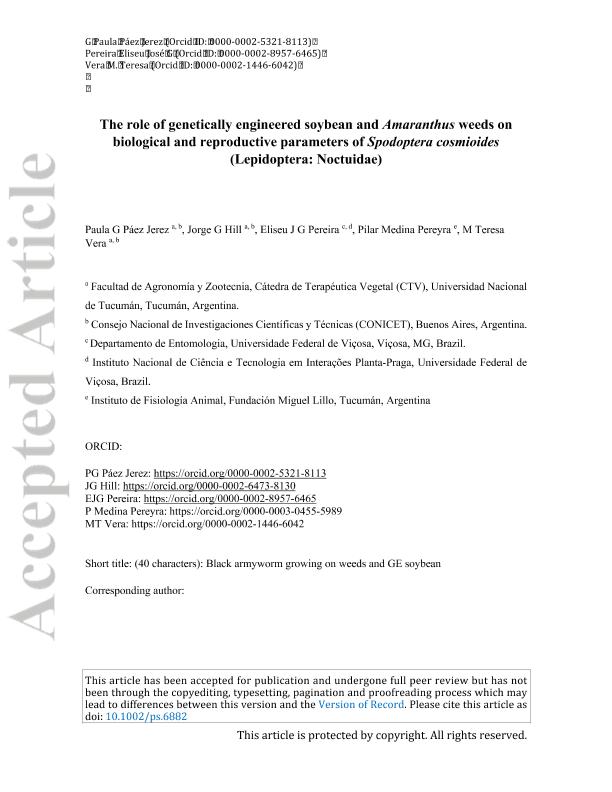Mostrar el registro sencillo del ítem
dc.contributor.author
Páez Jerez, Paula Gabriela

dc.contributor.author
Hill, Jorge Guillermo

dc.contributor.author
Pereira, Eliseu J. G.

dc.contributor.author
Medina Pereyra, Pilar
dc.contributor.author
Vera, María Teresa

dc.date.available
2023-10-31T12:52:55Z
dc.date.issued
2022-05
dc.identifier.citation
Páez Jerez, Paula Gabriela; Hill, Jorge Guillermo; Pereira, Eliseu J. G.; Medina Pereyra, Pilar; Vera, María Teresa; The role of genetically engineered soybean and Amaranthus weeds on biological and reproductive parameters of Spodoptera cosmioides (Lepidoptera: Noctuidae); John Wiley & Sons Ltd; Pest Management Science; 78; 6; 5-2022; 2502-2511
dc.identifier.issn
1526-498X
dc.identifier.uri
http://hdl.handle.net/11336/216527
dc.description.abstract
BACKGROUND: In soybean fields containing insecticide- and herbicide-resistant genetically engineered varieties, some weed species have increasingly become difficult to manage and may favor the population growth of secondary pests like Spodoptera cosmioides (Walker) (Lepidoptera: Noctuidae). To test this hypothesis, we measured life-history traits, population growth parameters and adult nutrient content of S. cosmioides reared on foliage from four Amaranthus species, from Cry1Ac Bt and non-Bt soybean varieties, and on meridic artificial diet. RESULTS: Larvae reared on A. palmeri and A. spinosus had a shorter development time (5–7 days) than larvae raised on the soybean varieties and A. hybridus. Armyworm survival probability was zero on A. viridis and highest (80% and 71%) on soybeans and A. palmeri. The latter and the artificial diet produced the heaviest larvae and pupae, in contrast to the non-Bt soybean variety. Body nutrient content diverged mostly for adults reared on artificial diet compared with those raised on the soybean varieties. The intrinsic rate of population increase (overall fitness) was 27.88% higher for the armyworms on A. palmeri, Cry1Ac Bt soybean and artificial diet compared with those on non-Bt soybean, A. spinosus and A. hybridus. CONCLUSIONS: Cry1Ac soybean fields infested by some Amaranthus weeds, especially A. palmeri, are conducive to the population growth of S. cosmioides. Integrated pest management programs may be needed to properly manage S. cosmioides in soybean fields, with surveillance for population peaks and judicious control measures when needed.
dc.format
application/pdf
dc.language.iso
eng
dc.publisher
John Wiley & Sons Ltd

dc.rights
info:eu-repo/semantics/openAccess
dc.rights.uri
https://creativecommons.org/licenses/by-nc-sa/2.5/ar/
dc.subject
ADULT NUTRIENT CONTENT
dc.subject
AGRICULTURAL LANDSCAPE
dc.subject
BLACK ARMYWORM
dc.subject
GM SOYBEAN
dc.subject
HOST QUALITY
dc.subject
LIFE-HISTORY TRAITS
dc.subject.classification
Otras Agricultura, Silvicultura y Pesca

dc.subject.classification
Agricultura, Silvicultura y Pesca

dc.subject.classification
CIENCIAS AGRÍCOLAS

dc.title
The role of genetically engineered soybean and Amaranthus weeds on biological and reproductive parameters of Spodoptera cosmioides (Lepidoptera: Noctuidae)
dc.type
info:eu-repo/semantics/article
dc.type
info:ar-repo/semantics/artículo
dc.type
info:eu-repo/semantics/publishedVersion
dc.date.updated
2023-10-30T18:00:38Z
dc.journal.volume
78
dc.journal.number
6
dc.journal.pagination
2502-2511
dc.journal.pais
Reino Unido

dc.journal.ciudad
Londres
dc.description.fil
Fil: Páez Jerez, Paula Gabriela. Consejo Nacional de Investigaciones Científicas y Técnicas. Centro Científico Tecnológico Conicet - Tucumán; Argentina. Universidad Nacional de Tucumán. Facultad de Agronomía y Zootecnia. Cátedra Terapéutica Vegetal; Argentina
dc.description.fil
Fil: Hill, Jorge Guillermo. Consejo Nacional de Investigaciones Científicas y Técnicas. Centro Científico Tecnológico Conicet - Tucumán; Argentina. Universidad Nacional de Tucumán. Facultad de Agronomía y Zootecnia. Cátedra Terapéutica Vegetal; Argentina
dc.description.fil
Fil: Pereira, Eliseu J. G.. Universidade Federal de Viçosa.; Brasil
dc.description.fil
Fil: Medina Pereyra, Pilar. Fundación Miguel Lillo; Argentina
dc.description.fil
Fil: Vera, María Teresa. Universidad Nacional de Tucumán. Facultad de Agronomía y Zootecnia. Cátedra Terapéutica Vegetal; Argentina. Consejo Nacional de Investigaciones Científicas y Técnicas. Centro Científico Tecnológico Conicet - Tucumán; Argentina
dc.journal.title
Pest Management Science

dc.relation.alternativeid
info:eu-repo/semantics/altIdentifier/doi/http://dx.doi.org/10.1002/ps.6882
Archivos asociados
